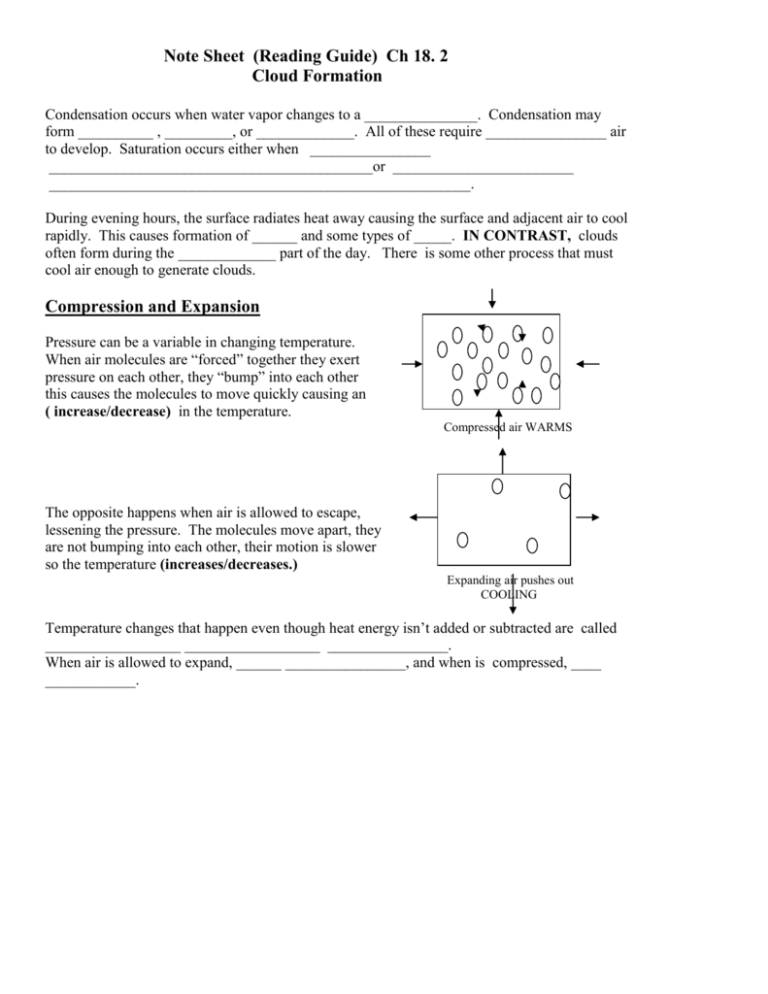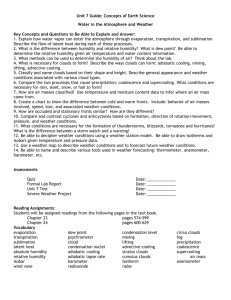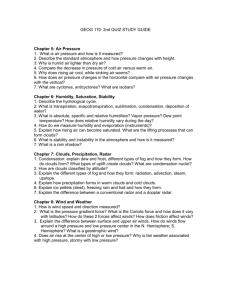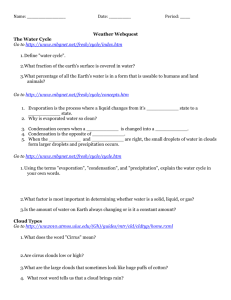Stable vs - Gilbert Public Schools
advertisement

Note Sheet (Reading Guide) Ch 18. 2 Cloud Formation Condensation occurs when water vapor changes to a _______________. Condensation may form __________ , _________, or _____________. All of these require ________________ air to develop. Saturation occurs either when ________________ ___________________________________________or ________________________ ________________________________________________________. During evening hours, the surface radiates heat away causing the surface and adjacent air to cool rapidly. This causes formation of ______ and some types of _____. IN CONTRAST, clouds often form during the _____________ part of the day. There is some other process that must cool air enough to generate clouds. Compression and Expansion Pressure can be a variable in changing temperature. When air molecules are “forced” together they exert pressure on each other, they “bump” into each other this causes the molecules to move quickly causing an ( increase/decrease) in the temperature. Compressed air WARMS The opposite happens when air is allowed to escape, lessening the pressure. The molecules move apart, they are not bumping into each other, their motion is slower so the temperature (increases/decreases.) Expanding air pushes out COOLING Temperature changes that happen even though heat energy isn’t added or subtracted are called __________________ __________________ ________________. When air is allowed to expand, ______ ________________, and when is compressed, ____ ____________. Expansion and Cooling As you move upward through the Earth’s atmosphere the pressure (increases/decreases). As a result, the ascending air ________ and __________. Unsaturated air cools at the constant rate of 10o C for every 1000 meters of ascent. Descending air encounters (more/less) pressure and is __________ 10o for every 1000 meters of decent. This rate of heating and cooling applies only to _________________ Air and is called the ________ ______________ _________. If air rises high enough, it will eventually cool to its ______ ________. Here ___________________ begins. During condensation energy is (absorbed/released). This means the “hidden heat” also known as __________ __________ stored in the atmosphere is released so it works against the cooling. Cooling will (speed up/ slow down). This is called the _______ ____________ _______. Complete the diagram: ______ Adiabatic Rate Cooling continues (slower/faster) Energy is (absorbed/released) Condensation Level _______________ Air Pressure is (increasing/decreasing) ______ Adiabatic Rate Air Temp. is (increasing/decreasing) Question: What happens to heat stored in water vapor when it is cooled to its dew point? Stable vs. Unstable Air Descriptions in terms of temperature, density and movement. (paraphrased) If air is forced to rise it will expand and temp. will (rise/fall). This air could then be cooler than the surrounding air and be (more dense/ less dense) . Now because of it’s temp. and density the air will (rise/fall). This is called __________ _______. This type of air tends to remain in position and is usually associated with fair weather. If air is very warm at the surface it will (rise/fall) and could be warmer than the surrounding air. Warm air is (less/ more ) dense, so it will continue to rise. This is called __________ air. When this happens clouds can form quickly and bring about dramatic changes in weather. Do not confuse adiabatic cooling rate with environmental lapse rate (covered in Ch. 17) Adiabatic temp. changes are changes in temperature caused by _______________ or _________________as air rises or descends. Environmental Lapse rate is the temperature changes measured by weather balloons. This is based on the surrounding geography and environmental factors. Temperature Inversion occurs when there is stable air aloft pressing down. As it descends it begin to warm by compression. The quick cooling evening air gets trapped against the earth by the descending warm air. Usually after sunrise the ground is heated and the inversion disappears. In some locations the inversion can be very thick due to uneven land surfaces. An example is Los Angeles where the chilled air near the surface being (more dense/ less dense) gradually drains down from the uplands and slopes into adjacent valleys. This creates an even thicker cold layer trapped under the descending air that is being warmed. Often this cold air contains much pollution and then does not dissipate easily after sunrise when the earth begins to warm again. Processes That Lift Air There are 4 mechanisms that can cause air to rise. Orographic Lifting - (describe) Example locations: Frontal Wedging – (describe) Example locations: Convergence – (describe) Example locations: Localized Convective Lifting – (describe) Example locations: Condensation For any form of condensation to occur, the air must _____ ____________________. There must be a solid surface for water vapor to condense on. When dew forms it settles on grass or car windows. But when condensation occurs in the air above the ground tiny particulate matter called _________________________ _____________. serve as surfaces. Examples of this particulate matter are _________________ ,_____________________, or __________________. This results in the formation of a _____________ consisting of millions upon millions of tiny ___________ ___________. They are all so fine that they remain suspended in air. Clouds 18.3 Clouds are an indication of what is going on in the atmosphere. 1. What is the basis for the classification of clouds? 2. List and describe the 3 forms of clouds 3. Describe the three height designations for clouds. Questions: What does the prefix alto mean? What does the prefix nimbus mean? Describe a nimbostratus cloud. Describe a cumulonimbus cloud. 4. Which cloud types are associated with the following characteristics: (some have multiple answers) Thunder- hail - Precipitation - lighting – Forms of Precipitation: add print out copy to your notebook









